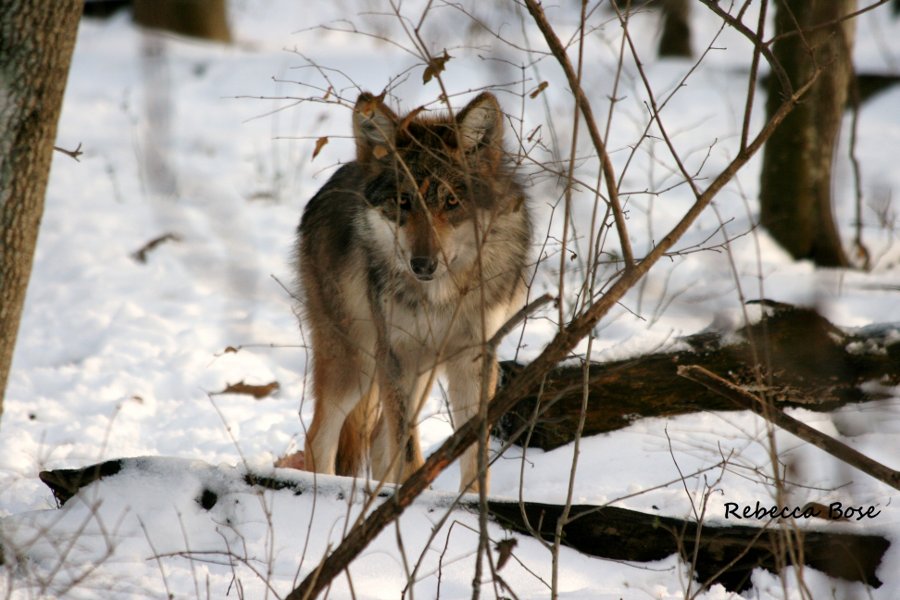In the News: Conservation efforts aim to save endangered Mexican gray wolves
 By Kitson Jazynka
By Kitson Jazynka
Aroooooo! Crystal the gray wolf throws her head back and howls. In the wild, the electrifying sound might carry for miles. At home in her wooded hillside enclosure at the Smithsonian’s National Zoo, she’s probably calling to her pack mate, Coby, or singing along with a wailing siren from an ambulance speeding past on Connecticut Avenue. Crystal howls with a high pitch. Coby joins in with her low voice.
These two 10-year-old wolves make up the pack that live within the zoo’s American Trail exhibit.
“Crystal and Coby show people that wolves are real, not just something in a picture or a show on TV,” says zoo animal keeper Sara Allison. “When you have a connection with a real animal, you’re more likely to want to protect it.”
An endangered species
Have you ever wondered about the meaning of the words “endangered” or “conservation”? “Endangered” means at serious risk of extinction. “Conservation” means working to save something precious, such as water or endangered wildlife.
For hundreds of thousands of years, wolves lived all over the world, from tundra to mountain to desert. But about 50 years ago, wolves nearly disappeared in the United States. They had been trapped, poisoned and shot to death because many people thought of them as pests and competition for such food animals as elk and deer.
Eventually, people realized that killing off wildlife harms our shared environment. In 1973, a law called the Endangered Species Act was enacted to protect animals and plants in danger of extinction. If not for this law, there would probably be no wild wolves (or other species such as grizzly bears and black-footed ferrets) left in the United States.
Return of the wolves
Thanks to conservation efforts and the resilience of the gray wolves themselves, populations have rebounded. In the United States, gray wolves can be found living in remote areas of Minnesota, Wisconsin, Oregon, Michigan, Idaho, Montana and Washington state.
In 2012, gray wolves in the Northern Rocky Mountains were “delisted,” or removed from the list of endangered animals. But the southernmost subspecies of the gray wolf — the Mexican gray — remains very much endangered.
“In the late [1970s] there were only seven Mexican gray wolves left on the planet,” says wolf conservationist Maggie Howell. She’s the director of the Wolf Conservation Center (WCC) in South Salem, New York. (It’s a nice coincidence that her name is pronounced “howl.”) She says that today there are approximately 83 Mexican gray wolves in the wild in Arizona, New Mexico and northern Mexico.
 Conservation groups such as the WCC are working with the U.S. government to help further expand the population of Mexican gray wolves. One member of the species, a wolf labeled M1141, was born in captivity at the WCC on Earth Day 2008 and will be released in northern Mexico any day now. “This gorgeous New Yorker will be a wild Mexican gray wolf,” Howell says. “He’ll face challenges, but we’re hopeful that he and his mate will soon have a litter of wild-born pups.”
Conservation groups such as the WCC are working with the U.S. government to help further expand the population of Mexican gray wolves. One member of the species, a wolf labeled M1141, was born in captivity at the WCC on Earth Day 2008 and will be released in northern Mexico any day now. “This gorgeous New Yorker will be a wild Mexican gray wolf,” Howell says. “He’ll face challenges, but we’re hopeful that he and his mate will soon have a litter of wild-born pups.”
As for Crystal and Coby, their life in captivity is more metropolitan than their wild cousins. Instead of hunting deer and moose, they nibble on kibble and a special wolf meatloaf served by caretakers. They also enjoy an occasional belly rub from their keepers.
No matter what their lifestyle, Howell says, “all of these wolves are an important piece of Mother Nature’s puzzle.”
— Kitson Jazynka
Jazynka is the author of “National Geographic Kids Mission: Wolf Rescue,” the second in a series of books on how kids can help endangered species.
This article was published by the Washington Post on May 16, 2014.
Photos courtesy of Rebecca Bose, Wolf Conservation Center
Click here to learn how to influence decision makers to make changes urgently needed for the long-term survival and recovery of Mexican wolves.
Donate to support our work for Mexican gray wolf recovery.
Click here to join our email list for Mexican gray wolf updates and action alerts.
Visit us on Facebook here.



